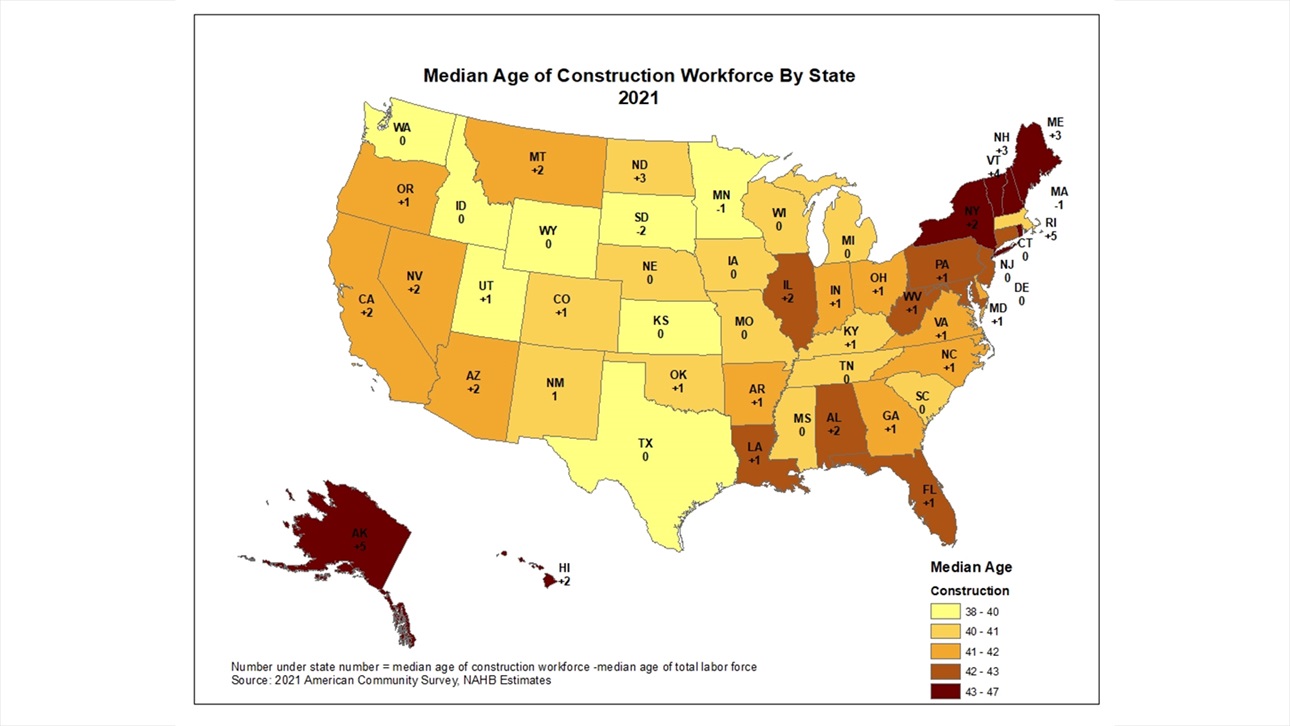Is the Construction Workforce Older than Other Industries?
Attracting skilled labor is still the primary long-term goal for construction, even though a slowing housing market has eased some pressure on current tight labor market conditions. So how does the construction industry stack up in terms of the age of its workforce?
According to NAHB analysis of the most recent 2021 American Community Survey (ACS) data, the median age of construction workers is 42. That’s one year older than a typical worker in the national labor force.
The median age of construction workforce varies across states. The median age of construction workers is highest in Maine and Vermont (47 years old), followed by New Hampshire and Rhode Island (46 years old), and then Alaska, Hawaii, New Hampshire and New York (44 years old).
Construction workers are younger on average in the central part of the nation. Half of all construction workers in South Dakota and Utah, for example, are under 38.
Similar patterns emerge when tracking the median age of construction workers against the median age of the workforce in each state. The median age of construction workers in Rhode Island and Alaska, for example, is five years older than the overall median, followed by Vermont (four years older). In South Dakota, on the other hand, the median age of construction workers is two years younger than the overall median.
The map below highlights both the median age of construction workers (color coded by age), as well as the difference between the median age of construction workforce in each state and the median age of the overall workforce. (A positive number indicates that, on average, construction workers are older than a typical worker in the state labor force, while a negative number indicates construction workers are younger.)
Na Zhao, principal economist at NAHB, provides a breakdown of median ages by individual construction job in this Eye on Housing post.

Latest from NAHBNow
Jan 08, 2026
NAHB Supports Trump Administration’s Lawsuit Against Local California Gas BansIn a move strongly supported by NAHB, the Trump administration on Jan. 5 sued two California cities over their ordinances banning natural gas infrastructure and appliances in new construction.
Jan 08, 2026
There is Always Something Happening on the IBS Show FloorThe NAHB International Builders’ Show (IBS) is the largest light construction conference in the world with more than 1,700 exhibitors spread out over the entirety of the convention center in Orlando.
Latest Economic News
Jan 07, 2026
State-Level Employment Situation: November 2025In November 2025, employment levels were largely unchanged across all states, with year-over-year growth holding near 2%. In contrast, construction employment showed greater variation, with some states experiencing declines of up to 7.5% while others posted gains approaching 10%.
Jan 07, 2026
Construction Job Openings Increased in NovemberThe count of open, unfilled positions in the construction industry increased in November, per the delayed Bureau of Labor Statistics Job Openings and Labor Turnover Survey (JOLTS). The current level of open jobs is down measurably from two years ago due to declines in construction activity, particularly in housing.
Jan 06, 2026
Mortgage Rates End 2025 at the Lowest Level of the YearLong-term mortgage rates have been declining since mid- 2025 and ended the year at their lowest level since September 2024. According to Freddie Mac, the 30-year fixed-rate mortgage averaged 6.19% in December, 5 basis points (bps) lower than November. Meanwhile, the 15-year rate declined 3 bps to 5.48%.
